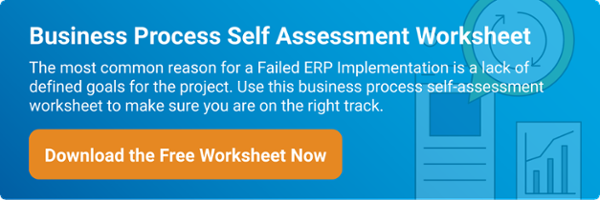Technology has brought about incredible changes to the world in a relatively short amount of time. We’re living in a world where all it takes is a quick Google search of “software for [insert issue here]” to be instantly presented with pages of solutions promising to solve your most pressing business problems. More often than not, these are user-friendly, cloud-based SaaS solutions that deploy almost immediately. While there are advantages to this best-in-class type of ecosystem, it can easily (and quickly) lead to a tangled web of siloed cloud systems, convoluted strategies, and manual, duplicative processes. And that’s where the business process review comes in.
Though it can add time and effort, a review of business processes is crucial in avoiding technological turmoil when bringing new software into the mix. Here’s what you need to know about them, including how to decide if one is required, how to conduct a thorough review of your current processes, and other helpful tips.
What is a Business Process Review?
Simply put, a business process review is an exercise that goes through the process flows existing in your business with the goal of identifying areas of improvement to become more agile, efficient, and streamlined.
Does my organization need a Business Process Review?
While every company could benefit from conducting a business process review, it’s only worth the time and effort if you have a specific problem you’re trying to solve or a goal you are trying to achieve. Furthermore, and perhaps most importantly, organizations must be ready and willing to make changes.
Business process reviews are particularly effective before organizations begin implementing new software systems. As a NetSuite partner, one of the most common inquires we receive is about the price of various software packages. While many decisions are driven by budget, the answer depends on many factors, including edition, number of users, add-ons, support, etc. Too often, companies are quoted a price, sold a software package, get up and running in a few months, only to come to the sad realization in six months that their business processes have not improved at all.
That’s why a business process review is critical; it helps to align processes, define goals, and thoughtfully plan and build solutions that help businesses achieve actual growth.
If that sounds a little jargony, think of it like this: If you built a house without footings, a solid foundation, and a well-thought-out floor plan, you probably wouldn’t be living in that house very long. If it hasn’t completely crumbled, you might find yourself walking through a pantry to get to the bathroom, which connects to the garage. That doesn’t sound very efficient.
The same idea holds with software. Without a holistic understanding of how organizations should use the software in your specific business—and why—you will never fully leverage its capabilities and, therefore, never realize the true ROI.
How to conduct a business process review
Suppose you’ve determined that your business could benefit from a business process review. In that case, the next step is to assemble a team of internal and external stakeholders that effectively strike a balance regarding your business’s intangibles. Intangible elements may include industry knowledge, implicit biases, and subject matter expertise.
End-users are often so ingrained in the day-to-day details of their job; it’s difficult to see how their role and responsibilities play into the overall business strategy. An unbiased partner can see the bigger picture and comprehend how each department is interlaced. Having a handle on your internal processes is important, but combining that with an external resolution is where the magic happens.
Here are some high-level steps to get started in conducting a business process review for your organization.
 |
#1: Prepare to Review Business ProcessesPreparation is essential when you conduct a business process review. You’ll need to define the scope and objectives of the review. This keeps everyone on topic and ensures everyone involved stays laser-focused on process management. You’ll also identify key stakeholders and gather relevant documentation. The stakeholders you choose should balance your business’s intangibles such as industry knowledge, implicit biases, and subject matter expertise. When you’re determining your goals, it may be helpful to consider these questions:
Companies who start with “why” will be better equipped to think through their needs and execute a tangible solution instead of relying on a temporary band-aid. |
 |
#2: Assemble Your TeamAs discussed earlier, the team assembled to conduct the review will be one of the most critical aspects of the exercise. It should be cross-functional and consist of managers and individual contributors to get the most holistic view of the issue(s) at hand and avoid tunnel vision. It’s helpful to include at least one external resource like 360 Cloud Solutions that can bring new ideas, perspectives, and insights as process experts to the table for consideration. |
 |
#3: Review Existing WorkflowTo start, you’ll review business processes your company uses right now, and create excellent process documentation on them if it doesn’t yet exist. Documentation of these process flows should include who’s involved, steps taken, bottlenecks or hand-offs, and talk with end-users if further clarification is needed. Keep in mind the Five Ws (who, what, where, when, why). Take heed; it is not unusual to discover that one thing leads to another, which, in turn, leads to many more. Keep going until you’ve exhausted the complete processes under review. You can’t streamline processes until you understand every step of them and see where the inefficiencies exist. |
 |
#4: Identify Areas for ImprovementNow that you have the documentation of your processes up to date, it’s time to take a closer look and go through the steps with a fine-toothed comb. You’re looking for inefficiencies, risks, and opportunities for improvement in these business systems—especially ones that, if improved, would directly improve company growth. It may be helpful to take a technology-agnostic view of what’s happening at the beginning. No business owner is excited to change technology or platforms, but if you start with opportunities and goals first, it may be easier to see when a change is the right next move to hit key company metrics. Think of it as a diagnosis and prognosis; identify the problems and a plan for improving them |
 |
#5: Process ReengineeringYou’ve done a process walkthrough and you can identify areas of improvement. You should now have your systems documented and understand what’s working and what’s lagging. Now’s the fun part. You and your review team can now think about what these processes should look like to support company growth—and reassess your existing tools if they don’t fit the bill. At this step, it’s wise to consider some of this plan’s realistic aspects, including a budget, resources, time, and measurable goals. If you are going to go through the effort of redesigning how your business is run, you need to document specific KPIs that will help you determine if it is helping or hurting. 360 Tip: Determining “to-be” and process reengineering is where the help of unbiased, third-party expertise truly comes into motion. |
 |
#6: Consider Technology LastYou might notice that not once did we discuss the actual technology or software that will enable you to achieve your goals in all of those steps. One common misstep in business process reviews or reengineering exercises is letting technology drive your processes. While it’s fine to assess whether you’re leveraging technology successfully or unsuccessfully, you should wait until the end of the process to evaluate specific solutions. Now that you have a firm grasp on your business’ unique needs and requirements, you can evaluate tech solutions to see if they offer the process flows you determined are ideal for your brand’s continuous improvement. |
Pulling it all together
You’ve had a great review period, and you and your team are ready to take the next step. So, what is that?
- Decide which technology best fits your new processes
- Go through a software update so your technology isn’t collecting dust
- Keep your documented processes up to date and circulate them to the whole team
- Book managed services with a company that can help with process implementation, like 360 Cloud Solutions if you decide to use NetSuite
Not quite ready to embark on a full-scale business process review?
360 Solutions has you covered. Download a copy of our free business process self-assessment worksheet to help you understand your current business processes and where gaps may be occurring in your operations:




